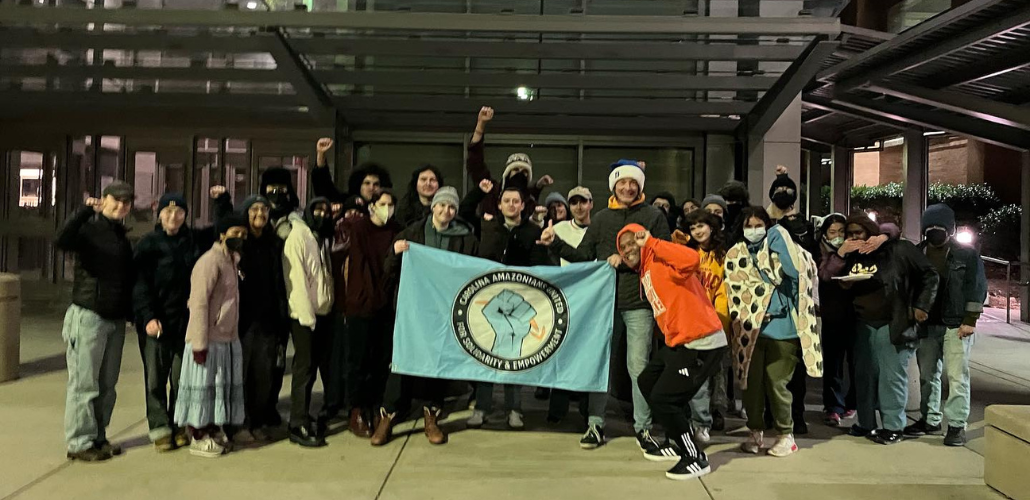Amazon Stokes Racial Divides in Lead-Up to North Carolina Union Vote

Amazon workers and community supporters offered jail support after a former worker and two supporters were arrested while handing out food and collecting signed union cards on December 6. Photo: CAUSE
Four thousand workers at a North Carolina Amazon warehouse are voting February 10-15 on whether to unionize with Carolina Amazonians United for Solidarity & Empowerment.
RDU1, in the town of Garner, outside Raleigh, would be the second unionized Amazon warehouse in the United States.
It’s an ambitious campaign. The workers are organizing across racial and ethnic divides, through constant turnover, in deeply hostile terrain. At 2.4 percent, North Carolina’s union density is the lowest in the country.
They’ll also need to overcome widespread fear of something Amazon is notorious for: retaliation. In January, Amazon abruptly outsourced its entire Quebec operation rather than be forced to accept a contract at one warehouse.
In North Carolina, it has fired several visible union supporters, including CAUSE President Rev. Ryan Brown.
AN ANTI-UNION ARMY
On January 7, the National Labor Relations Board ruled that workers at RDU1 had signed enough union authorization cards to trigger an election.
“Three days later, Amazon mobilized an army,” said Marcela Duron, a stower. (Duron requested a pseudonym for fear of retaliation.) “Holding meetings, handing out pamphlets, all against CAUSE.”
Anti-union posters started showing up all over the building, even in the bathrooms. New faces appeared on the warehouse floor asking how workers felt about the union. Workers received a mailer at home linking to an anti-union website and urging them to vote no.
“If you’re on the floor talking to somebody, they will be there waiting like vultures to get to the person that you just talked to,” said Italo Medelius-Marsano, who has worked there since 2022. “They’ve already figured out who the union leaders are. They have very good intelligence. It’s almost like they’re union organizers, but on the other side.”
One night before the voting began, Garner police arrested an Amazon Labor Union leader who had come from New York to support the union campaign. In December, they arrested two community members and a fired Amazon worker who were flyering at the warehouse door.
“Under the National Labor Relations Act I should have been allowed to flyer on the premises,” said Orin Starn, who had worked at Amazon for six months. “But the police, who in the small town of Garner where Amazon is the biggest employer act as a kind of private security force, didn't care and just took us off to jail.”
SCARCE LOCAL JOBS
The sprawling 2 million-square-foot warehouse is built on the site of a ConAgra Foods plant that was shut down after an explosion in 2009 killed four workers and injured dozens more. At the time, the plant was the largest employer in Garner—but rather than rebuild it, ConAgra opted to shift production to Ohio, putting 600 people out of work.
The space sat idle until Amazon opened this facility in 2020. It’s now one of the largest employers in the county—a fact that isn’t lost on workers.
“Some people in the building are afraid because they’re refugees, so they don’t want to draw attention,” said Duron. Others are afraid of losing hours, or their jobs altogether. Though the work is grueling, many feel it’s the best option available, “and Amazon has taken advantage of that.”
Workers feel that Amazon has seized on racial divisions in the workforce. “It’s mostly the Hispanic community that Amazon has been intimidating, that we could lose our benefits or possibly our jobs,” said Marcos Pedroza, who has worked at the warehouse for three years in a number of roles. (Pedroza, too, requested a pseudonym for fear of retaliation.)
“Many Hispanic workers say they’re against the union so they don’t get harassed, but they’ve told me they’re voting yes,” Pedroza said.

SUPPORT LABOR NOTES
BECOME A MONTHLY DONOR
Give $10 a month or more and get our "Fight the Boss, Build the Union" T-shirt.
DIVIDE AND CONQUER?
“Amazon’s strategy is very blatantly: get the Latino vote,” said Medelius-Marsano. “What we hear from people in all departments, in all shifts, is that Amazon is painting CAUSE as a Black union and saying, ‘All the Black folks are lazy and the Hispanics are the ones that work the hardest, and the union is only trying to protect lazy people.’” Amazon disputes the allegations.
A week before the union vote, an Amazon manager claimed the union had told workers they could be deported if they vote no—a claim Medelius-Marsano characterized as “absolutely disgusting” and “a complete falsity.”
“They’ve found fractures in this situation, and have capitalized on it well: on the prejudices of [some] Hispanic workers, differences between ethnic groups,” said Duron.
“I tell them, what are your roots?” says Pedroza. “Venezuela has African roots. Puerto Ricans are a mix of Africans, Spaniards, and Taínos. Why are you going to put something racial on a dark-skinned person when we have that in our blood, in our DNA?”
ORGANIZING IN FOUR LANGUAGES
Bosses have been exploiting racial divisions for as long as they’ve been beating back union campaigns. CAUSE can’t win without confronting the division head-on.
But the workplace divides have also helped make the case for the union. “We [functionally] don’t have an HR; there’s no one who consistently speaks Spanish,” Pedroza said. “At the Wellness Center, [too], no one [consistently] speaks Spanish.”
Training materials at the facility are often only available in English, a CAUSE newsletter asserted, “leading to misunderstandings and increased risk of accidents and injuries.” (Amazon says it has bilingual HR staff at the warehouse who help with translations.)
The union newsletters, now available in French, Spanish, and Arabic in addition to English, reflect efforts to build a coalition across language barriers.
The establishment of a Latino organizing committee was a turning point. “The organization boomed after that,” Medelius-Marsano said. “Within three to four months, we had at least 30 really strong Spanish-speaking leaders that were showing up weekly, and we were figuring out how we’re going to achieve full coverage of the warehouse.”
With time, the English-language organizing committee secured a Spanish-English interpreter, helping workers to connect and build relationships across language barriers.
‘NEVER LEARNED MY NAME’
When Amazon removed a statement “in solidarity” with Black employees from its website earlier this year, CAUSE was quick to respond in its newsletter: “Company policy can change at any time. Union contracts only change with our vote.”
One of the most common frustrations workers share is the perception that Amazon is not invested in them for the long haul. “You’re an old timer at RDU1 if you reach six months,” Medelius-Marsano said. “I was working in packing for over a year, and my manager never learned my name. I was just my username on our badge.”
“When you start here, everyone loses weight because of the sheer physical effort,” Duron said. “Amazon is one of the largest companies on the planet, and it has the resources to offer better working conditions.”
“People are going to the [anti-union] meetings just to get a break from work,” Pedroza said. “They can rest for an hour, so people keep going to the meetings. Then when they leave, they tell me, ‘I’m voting for the union.’”
Some quotes have been translated from Spanish to English.






